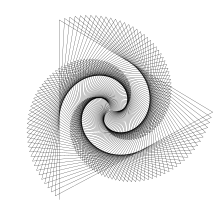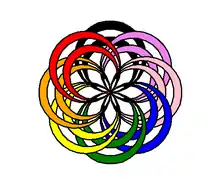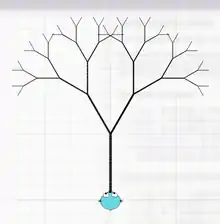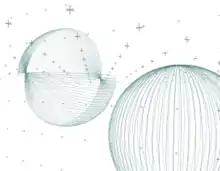Turtle graphics
In computer graphics, turtle graphics are vector graphics using a relative cursor (the "turtle") upon a Cartesian plane. Turtle graphics is a key feature of the Logo programming language.[1]
Overview




The turtle has three attributes: a location, an orientation (or direction), and a pen. The pen, too, has attributes: color, width, and on/off state.
The turtle moves with commands that are relative to its own position, such as "move forward 10 spaces" and "turn left 90 degrees". The pen carried by the turtle can also be controlled, by enabling it, setting its color, or setting its width. A student could understand (and predict and reason about) the turtle's motion by imagining what they would do if they were the turtle. Seymour Papert called this "body syntonic" reasoning.
A full turtle graphics system requires control flow, procedures, and recursion: many turtle drawing programs fall short. From these building blocks one can build more complex shapes like squares, triangles, circles and other composite figures. The idea of turtle graphics, for example is useful in a Lindenmayer system for generating fractals.
Turtle geometry is also sometimes used in graphics environments as an alternative to a strictly coordinate-addressed graphics system.
History
Turtle graphics are often associated with the Logo programming language.[2] Seymour Papert added support for turtle graphics to Logo in the late 1960s to support his version of the turtle robot, a simple robot controlled from the user's workstation that is designed to carry out the drawing functions assigned to it using a small retractable pen set into or attached to the robot's body. Turtle geometry works somewhat differently from (x,y) addressed Cartesian geometry, being primarily vector-based (i.e. relative direction and distance from a starting point) in comparison to coordinate-addressed systems such as bitmaps or raster graphics. As a practical matter, the use of turtle geometry instead of a more traditional model mimics the actual movement logic of the turtle robot. The turtle is traditionally and most often represented pictorially either as a triangle or a turtle icon (though it can be represented by any icon).
Today, the Python programming language's standard library includes a Turtle graphics module.[3] Like its Logo predecessor, the Python implementation of turtle allows programmers to control one or more turtles in a two-dimensional space. Since the standard Python syntax, control flow, and data structures can be used alongside the turtle module, turtle has become a popular way for programmers learning Python to familiarize themselves with the basics of the language.[4]
Extension to three dimensions


The ideas behind turtle graphics can be extended to include three-dimensional space. This is achieved by using one of several different coordinate models. If the turtle operates in cylindrical coordinates, then it has a location and a heading within its plane, and its plane may be rotated around the vertical axis. This often manifests itself as the turtle having two different heading angles, one within the plane and the other determining the plane's angle. Usually changing the plane's angle does not move the turtle.
Other coordinate models may also be used. Cheloniidae Turtle Graphics is a 3D turtle library for Java.[5]
References
- Goldman, Ron; Schaefer, Scott; Ju, Tao. "Turtle Geometry in Computer Graphics and Computer Aided Design" (PDF). CSE.WUSTL.edu.
- Thornburg, David D. (March 1983). "Friends of the Turtle: On Logo And Turtles". Compute!. p. 148. Retrieved 6 October 2013.
- "25.1. turtle — Turtle graphics — Python 3.7.0 documentation". docs.python.org. Retrieved 2018-08-23.
- "3. Hello, little turtles! — How to Think Like a Computer Scientist: Learning with Python 3". python.camden.rutgers.edu. Retrieved 2018-08-23.
- Spencer Tipping on cheloniidae(retrieved 2016-9-17)
Further reading
- Papert, Seymour (1993). Mindstorms: Children, Computers, and Powerful Ideas (2nd ed.). New York: Basic Books. ISBN 0-465-04674-6. OCLC 794964988.
- Papert, Seymour (1993). The Children's Machine: Rethinking School in the Age of the Computer. New York: Basic Books. ISBN 0-465-01830-0. OCLC 248428992.
